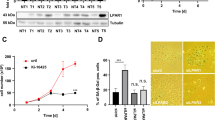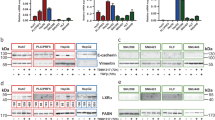Abstract
Hepatocyte Growth Factor (HGF) exerts its biological effects via binding and activating a transmembrane protein tyrosine kinase receptor known as c-Met. Previous studies from our laboratory demonstrated that c-met gene expression is inducible by its own ligand (HGF). However, the molecular mechanism(s) involved in this process are unknown. The present study was carried out to address this question. Transfection of various c-met-CAT promoter constructs into the mouse hepatocellular carcinoma cell line Hepa 1-6 in combination with electrophoretic mobility shift assays (EMSA) identified the responsive element as an activated protein-1 (AP-1) binding site (TGAGTCA) within the c-met core promoter region at position −158 to −152. The c-met AP-1 element binds specifically to AP-1 protein as verified by supershift assays. EMSA studies and mutational analyses of the promoter region also revealed that the members of the Sp family of transcription factors (Sp-1 and Sp-3) bind to the c-met Sp-1 element (located at position −124) which is adjacent to the AP-1 site. We show that Sp binding dampens binding of AP-1 to its cognate site in the c-met promoter region. Stimulation of Hepa 1-6 cells with HGF resulted in a rapid and dramatic enhancement of the AP-1 binding activity as well as an overall increase in the level of AP-1 protein. Cotransfection of AP-1 expression vectors (c-Fos plus c-Jun) with c-met promoter constructs resulted in stimulation of c-met promoter activity. We found that transactivation of the c-met promoter by AP-1 can be blocked by Curcumin, an inhibitor of AP-1. Moreover, we found that the induction of the endogenous c-met gene by HGF is inhibited by the addition of Curcumin. The results demonstrate that the HGF-induced transcription of the c-met gene by HGF is, at least in part, due to activation of the AP-1 pathway.
This is a preview of subscription content, access via your institution
Access options
Subscribe to this journal
Receive 50 print issues and online access
$259.00 per year
only $5.18 per issue
Buy this article
- Purchase on Springer Link
- Instant access to full article PDF
Prices may be subject to local taxes which are calculated during checkout





Similar content being viewed by others
References
Ahmad M, Theofanidis P and Medford RM. . 1998 J. Biol. Chem. 273: 4616–4621.
Bell A, Chen Q, DeFrances MC, Michalopoulos GK and Zarnegar R. . 1999 Oncogene 18: 887–895.
Bladt F, Riethmacher D, Isenmann S, Aguzzi A and Birchmeier C. . 1995 Nature 373: 702–705.
Blume SW, Snyder RC, Ray R, Thomas S, Koller CA and Miller DM. . 1991 J. Clin. Invest. 88: 1613–1621.
Boccaccio C, Gaudino G, Gambarotta G, Galimi F and Comoglio PM. . 1994 J. Biol. Chem. 269: 12846–12851.
Bottaro DP, Rubin JS, Faletto DL, Chan AM, Kmiecik TE, Vande Woude GF and Aaronson SA. . 1991 Science 251: 802–804.
Chen Q, Seol DW, Carr B and Zarnegar R. . 1997 Hepatology 26: 59–66.
Chen YR and Tan TH. . 1998 Oncogene 17: 173–178.
Gambarotta G, Boccaccio C, Giordano S, Ando M, Stella MC and Comoglio PM. . 1996 Oncogene 13: 1911–1917.
Greenwel P, Inagaki Y, Hu W, Walsh M and Ramirez F. . 1997 J. Biol. Chem. 272: 19738–19745.
Huang TS, Lee SC and Lin JK. . 1991 Proc. Natl. Acad. Sci. USA 88: 5292–5296.
Janson L and Pettersson U. . 1991 Gene 109: 297–301.
Jeffers M, Fiscella M, Webb CP, Anver M, Koochekpour S and Vande Woude GF. . 1998 Proc. Natl. Acad. Sci. USA 95: 14417–14422.
Jeffers M, Rao MS, Rulong S, Reddy JK, Subbarao V, Hudson E, Vande Woude GF and Resau JH. . 1996 Cell Growth Differ. 7: 1805–1813.
Jiang J-G, Chen Q, Bell A and Zarnegar R. . 1997 Oncogene 14: 3039–3049.
Karin M. . 1995 J. Biol. Chem. 270: 16483–16486.
Kida M, Souri M, Yamamoto M, Saito H and Ichinose A. . 1999 J. Biol. Chem. 274: 6138–6147.
Lee W, Mitchell P and Tjian R. . 1987 Cell 49: 741–752.
Leiden JM, Yang LH, Morle GD, June CH, Lindsten T, Thompson CB and Karpinski B. . 1989 J. Autoimmun. 2: (Suppl) 67–79.
Liu Y, Michalopoulos GK and Zarnegar R. . 1994 J. Biol. Chem. 269: 4152–4160.
Maffe A and Comoglio PM. . 1998 Eur. J. Morphol. 36: (Suppl) 74–81.
Marks-Konczalik J, Chu SC and Moss J. . 1998 J. Biol. Chem. 273: 22201–22208.
Naldini L, Weidner KM, Vigna E, Gaudino G, Bardelli A, Ponzetto C, Narsimhan RP, Hartmann G, Zarnegar R, Michalopoulos GK, et al. 1991 EMBO J. 10: 2867–2878.
Rodrigues GA, Park M and Schlessinger J. . 1997 EMBO J. 16: 2634–2645.
Seol DW, Chen Q, Smith ML and Zarnegar R. . 1999 J. Biol. Chem. 274: 3565–3572.
Seol DW and Zarnegar R. . 1998 Biochim. Biophys. Acta 1395: 252–258.
Sonnenberg JL, Rauscher FJD, Morgan JI and Curran T. . 1989 Science 246: 1622–1625.
Srivastava S, Weitzmann MN, Kimble RB, Rizzo M, Zahner M, Milbrandt J, Ross FP and Pacifici R. . 1998 J. Clin. Invest. 102: 1850–1859.
Tamagnone L and Comoglio PM. . 1997 Cytokine Growth Factor Rev. 8: 129–142.
Uehara Y, Minowa O, Mori C, Shiota K, Kuno J, Noda T and Kitamura N. . 1995 Nature 373: 702–705.
Weir E, Chen Q, DeFrances MC, Bell A, Taub R and Zarnegar R. . 1994 Hepatology 20: 955–960.
Zarnegar R and Michalopoulos GK. . 1995 J. Cell Biol. 129: 1177–1180.
Zhang Y, Feng XH and Derynck R. . 1998 Nature 394: 909–913.
Acknowledgements
The authors would like to thank Dr Marie C DeFrances for critical reading of this manuscript. This work was supported by a grant (RPG-91-009-10-CNE) from the American Cancer Society awarded to R Zarnegar.
Author information
Authors and Affiliations
Rights and permissions
About this article
Cite this article
Seol, DW., Chen, Q. & Zarnegar, R. Transcriptional activation of the Hepatocyte Growth Factor receptor (c-met) gene by its ligand (Hepatocyte Growth Factor) is mediated through AP-1. Oncogene 19, 1132–1137 (2000). https://doi.org/10.1038/sj.onc.1203404
Received:
Revised:
Accepted:
Published:
Issue Date:
DOI: https://doi.org/10.1038/sj.onc.1203404
Keywords
This article is cited by
-
PA1 participates in the maintenance of blood–testis barrier integrity via cooperation with JUN in the Sertoli cells of mice
Cell & Bioscience (2022)
-
MACC1 promotes pancreatic cancer metastasis by interacting with the EMT regulator SNAI1
Cell Death & Disease (2022)
-
EGFR-TKI resistance promotes immune escape in lung cancer via increased PD-L1 expression
Molecular Cancer (2019)
-
Studies on combination of oxaliplatin and dendrosomal nanocurcumin on proliferation, apoptosis induction, and long non-coding RNA expression in ovarian cancer cells
Cell Biology and Toxicology (2019)
-
Targeting the COX2/MET/TOPK signaling axis induces apoptosis in gefitinib-resistant NSCLC cells
Cell Death & Disease (2019)



